Related Content
Content
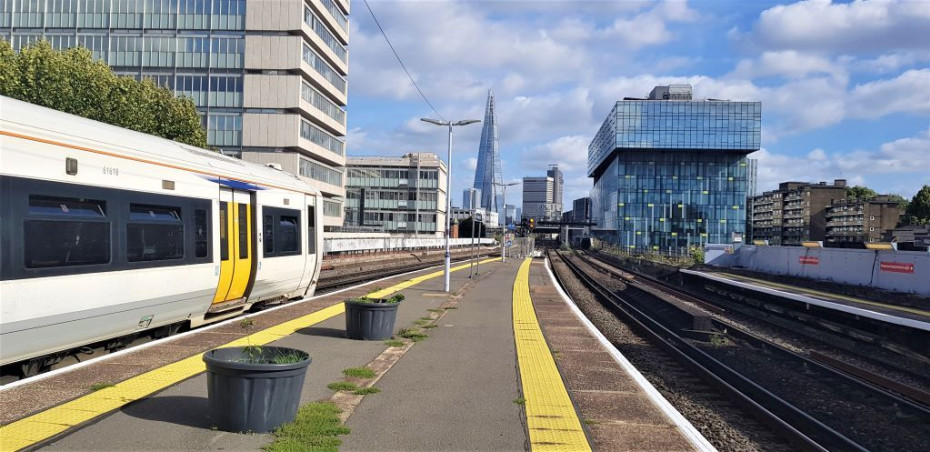
Share
The guides on how to travel between Waterloo and the other London stations are focused on, or at least include, the easiest routes, so that the simpler alternatives when travelling with heavy luggage or with young children etc can be followed.
At weekends the Underground lines and both the Elizabeth line and Thameslink trains can be impacted by construction work.
Those affecting the Underground and Elizabeth line trains can be looked up here, while those impacting the Thameslink trains, can be found here.
Good to know:
All of the four Underground lines which serve Waterloo, the Bakerloo, Jubilee Northern and the Waterloo and City line, are deep-level tube lines.
So the connections on to other central London stations are somewhat compromised, with taking a bus from Waterloo often being an easier option.
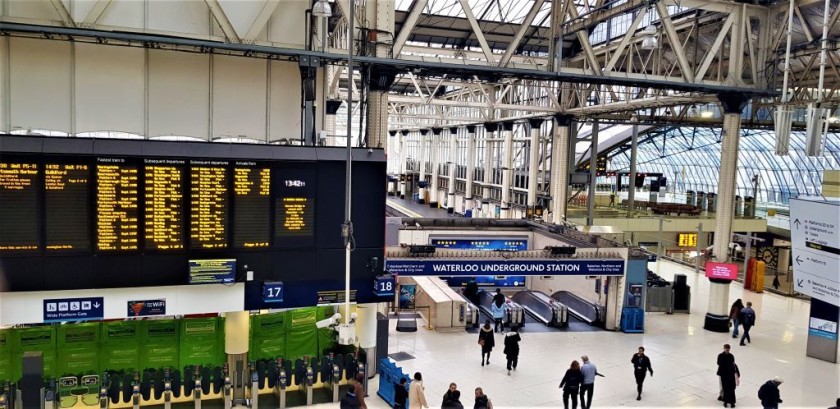
There are three entrances to the Underground station on the main concourse, the one which is opposite platforms 4 -5 is the quickest route to the Jubilee Line.
The shortest route from the concourse to the Bakerloo and Northern lines, is to use the entrance to the Underground which is beside the entrance on the concourse to platform (track) 17, which is pictured above.
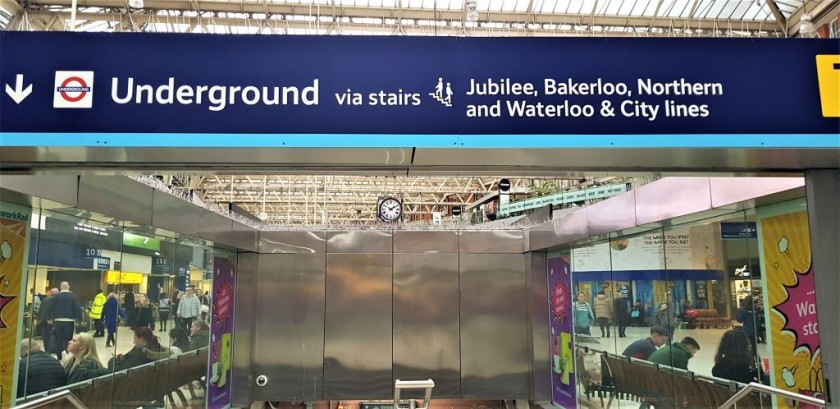
By platform 4 and 5 on the concourse is this alternative route to all four of the Underground lines, which serve Waterloo.
It provides the quickest access from this side of the station to the Waterloo and City line, which on Mondays to Saturdays provides a one-stop hop to Bank station, but avoid this entrance if you'll be taking the other lines, because it isn't actually a short-cut.
Something also worth being aware of is that step-free access is available to the Bakerloo, Jubilee and Waterloo & City lines, but the platforms that the Northern line trains use can only be accessed by using a short flight of stairs.
A Summary of how the ticketing works
All of the ticket gates at central London stations have 'readers' which enable contactless payment.
Regardless of whether you are resident in the UK, or are visiting, there are three methods of using Contactless:
- A payment app on a mobile device, including your bank's contactless payment app, or the likes of Google Pay, Apple Pay, or Samsung Pay.
- A debit / credit card as long as it has the contactless symbol
- An Oyster card (you touch in and out as you do when using Contactless).
Good to know about using Contactless
- The system works by touching in and out.
- When using bank cards, take care to use the same card when touching out at the end of a journey, as you did when touching in at the start.
- You have to pay with Contactless on the regular red buses, you cannot pay with cash.
- When travelling by the Underground or Elizabeth line, you can save 10 - 20p per journey by paying with a banking app / card instead of an Oyster card.
- Making a Contactless payment is cheaper than buying a ticket from a station counter or machine - the price difference is usually at least 50%!
More info is available on the general London by train guide.
From Waterloo:
What aren't included below are guides to how to travel to and from the other stations in central London, which are primarily also used by trains which travel between destinations to the south of the city and the capital.
Both Charing Cross and London Bridge can be accessed by frequent trains from Waterloo (East) station - one of these trains is pictured at the top of the page.
It has step-free access from the main concourse, a bridge to this separate station leads off from the upper balcony and sloped ramps lead down to the trains.
Most trains to Waterloo stop at Clapham Junction station, where step-free connections are available with trains heading to Victoria station.
to Euston
The northbound Northern line provides a direct connection to Euston station, but it's an always busy seven-station journey.
Also on arrival at Euston, a combination of short flight of stairs + an escalator + a lift provides the optimum route to the main concourse in the station.
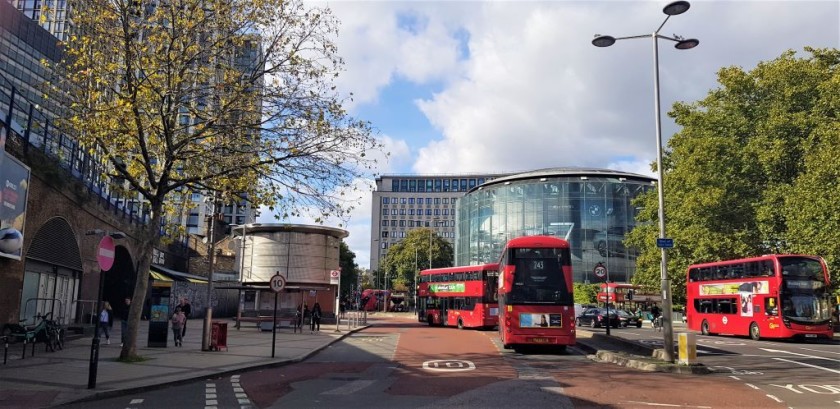
The alternative is to head to bus stop K from where lines/routes 68 and 168 go to Euston from Waterloo.
Leave the station by Victory Arch exit, head down to the main road, you'll see in front of you and then turn right.
Or head down to the exit on Waterloo Road, through the Jubilee line ticket hall, turn to the left once you're outside the station and walk ahead under the bridges which span the road.
The buses will arrive in Euston at the bus station which is directly in front of the railway station.
to King's Cross and St Pancras
A quick glance at the Underground map reveals the lack of a direct link from Waterloo to the Underground station named 'King's Cross, St Pancras', which serves both of these stations.
Of the multiple options with connections, SMTJ's preference is to take a northbound Bakerloo line and connect at Piccadilly Circus into a northbound Piccadilly line train.
Two reasons; seats and space for luggage will likely be available on the Bakerloo line train, as it will have made only two prior station calls, plus an escalator link is available between the two lines at Piccadilly Circus.
There isn't a direct bus route/line to provide an alternative to taking the Underground, but there is a step-free route available from Waterloo to King's Cross and to St Pancras.
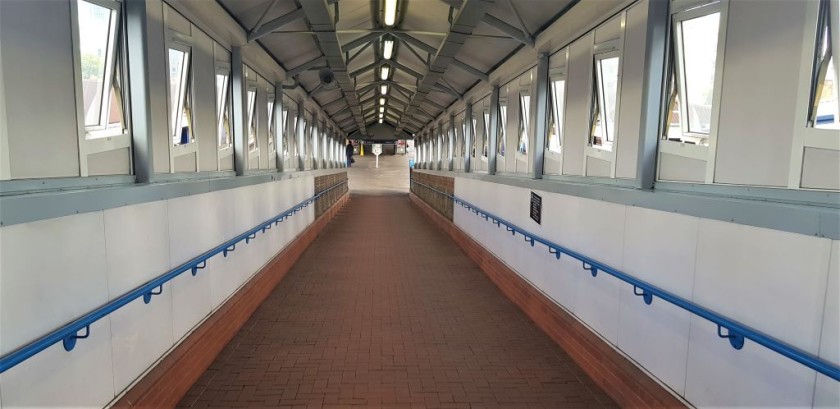
- Waterloo East station is linked to the main station by a footbridge that can be accessed from the main concourse by escalators and a lift (elevator), then in Waterloo East station slopes, pictured above, lead down to the trains.
- All trains which depart from platforms/tracks A and C in Waterloo East will call at London Bridge, there is a departure indicator which will tell you whether the next train will be leaving from platform A or C, typically more than fifteen trains per hour will be available.
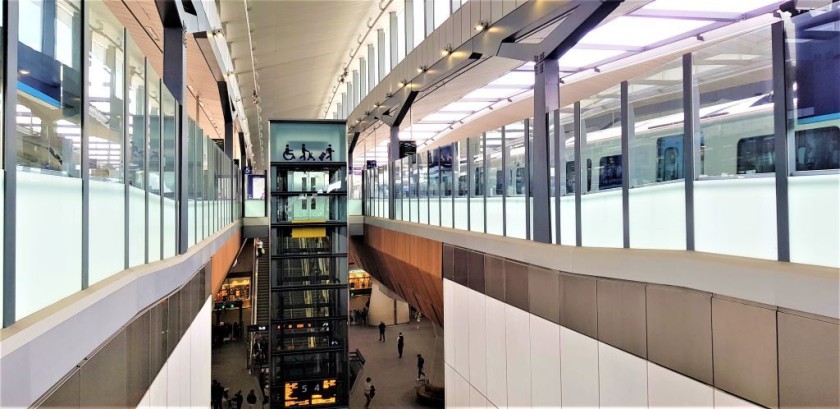
- At London Bridge lifts/elevators will be available to connect to the main concourse, where steps away, another lift/elevator will take you up to platform 5.
- Twelve trains per hour from platform 5 will usually be making the 15 min journey to St Pancras International station, so the end-to-end journey from Waterloo to St Pancras by this route will typically take 30 - 40 minutes
- On arrival at St Pancras escalators and elevators lead up to the main concourse and an entrance to King's Cross station is within a minute's walk.
Turn left on exiting the Thameslink station and then walk ahead to the exit you'll then see on the far side of the building, which leads on to Pancras Road.
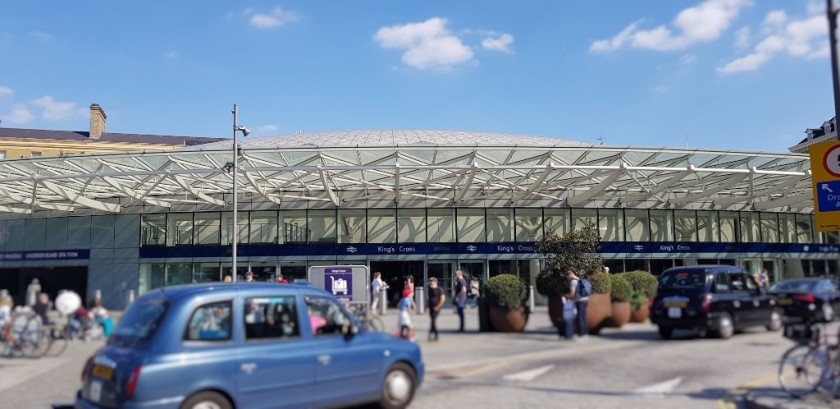
On exiting St Pancras International you will then see the entrance to King's Cross station pictured below, just across the street.
to Liverpool Street
There is no direct Underground link from Waterloo to Liverpool Street, though if you don't have luggage etc, a comparatively easy one-train option is to take the Waterloo and City line to Bank station, and then walk for five to 10 minutes along Threadneedle Street.
Though avoid making the transfer at Bank station into the Central line on to Liverpool Street, because if you're happy to make a transfer between trains, the better option is to take a northbound Northern line train to Tottenham Court Road and connect there for an eastbound Elizabeth line train.
However, if the train you will be connecting into calls at Stratford, then a typically faster option is to travel there from Waterloo on an eastbound Jubilee line train and then make the transfer at Stratford station.
Trains heading to multiple destinations including Colchester, Ipswich, Norwich and Southend will typically call at Stratford.
to Paddington and Marylebone
The northbound Bakerloo line trains go direct to Marylebone and Paddington stations from Waterloo.
to Waterloo
Note the advice for how to access Waterloo from another station can vary from that on how to travel to a station from Waterloo, for multiple reasons including the availability of lifts (elevators) in various locations and the access to and from bus stops.
from Euston
The fastest option is take a southbound Northern line train via Charing Cross, though a short flight of stairs is the final stage of making the transfer from the main concourse at Euston to these Underground trains.
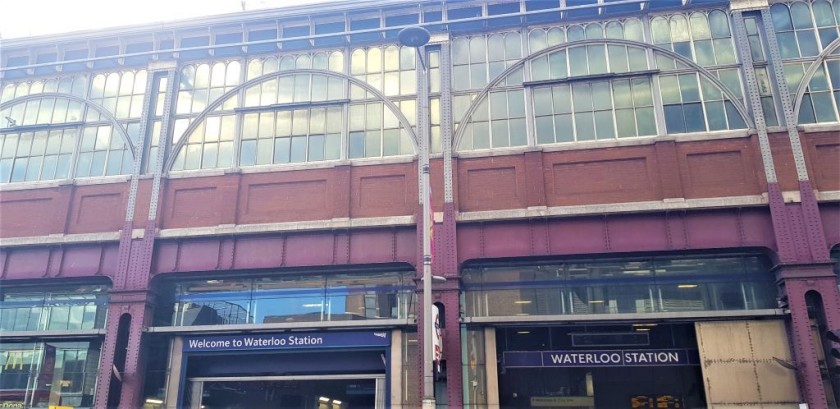
However, if time is on your side bus route 68 goes from stop E in the bus station.
Though on arrival at Waterloo you will need to cross the road and enter the part of the station, pictured above which gives access to the Jubilee line; From there escalators and lifts (elevators) can take you up to the main station concourse.
from King's Cross
There isn't a direct Underground Line to Waterloo station from King's Cross, but of the many options, SMTJ's preference is to take the Piccadilly Line southbound to Leicester Square and connect there into the southbound Northern line, as the connection between the two lines at Leicester Square involves a comparatively short set of stairs.
Though at Piccadilly Circus station an escalator link is available to the southbound Bakerloo line.
Or if you'll have heavy luggage etc, the less obvious, but escalator avoidance route from King's Cross to Waterloo is:
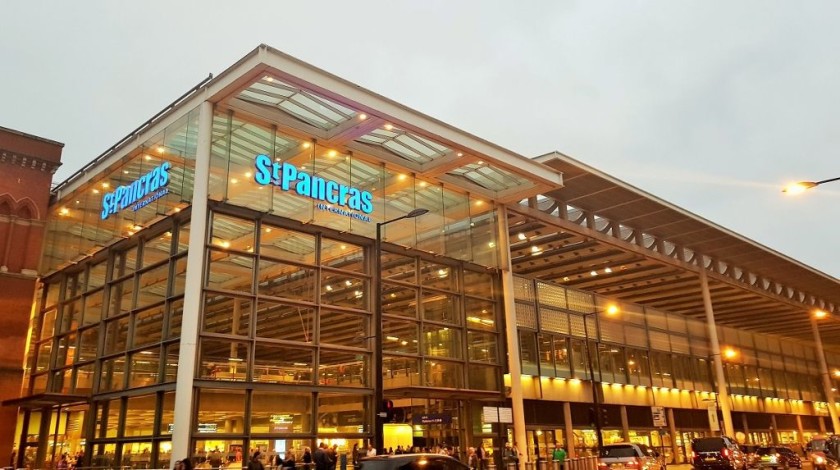
- Head over the street to St Pancras station, using the exit at King's Cross on to Pancras Road, which leads off from the main concourse on the opposite side to the departure boards.
- Once you have entered St Pancras International go straight ahead and you will then see the entrance to the part of the station, used by Thameslink trains, over to the right, on the other side of a ticket desk.
- A lift and escalators will be available down to platform A from where up to 12 trains will depart for London Bridge.
4 At London Bridge station lifts (elevators) and escalators will enable easy access to platforms 8 and 9, from where all the trains will call at Waterloo (East); trains depart at least every 5 minutes.
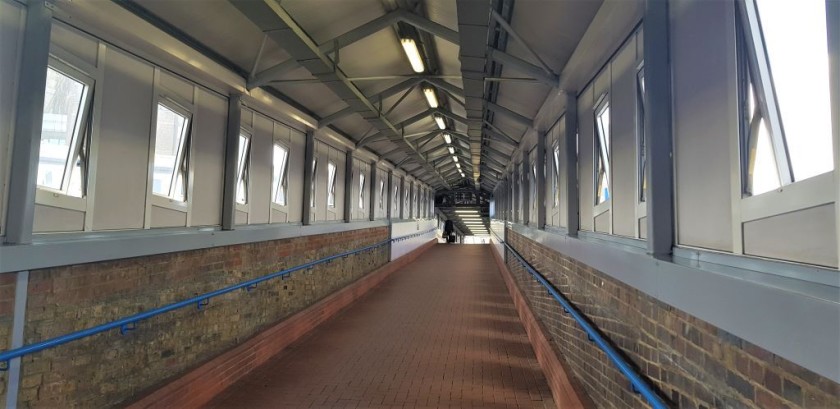
- Waterloo (East) station is adjacent to the main station at Waterloo, to which it has step-free access by a footbridge, though a fairly step slope, pictured above leads up to it from the trains.
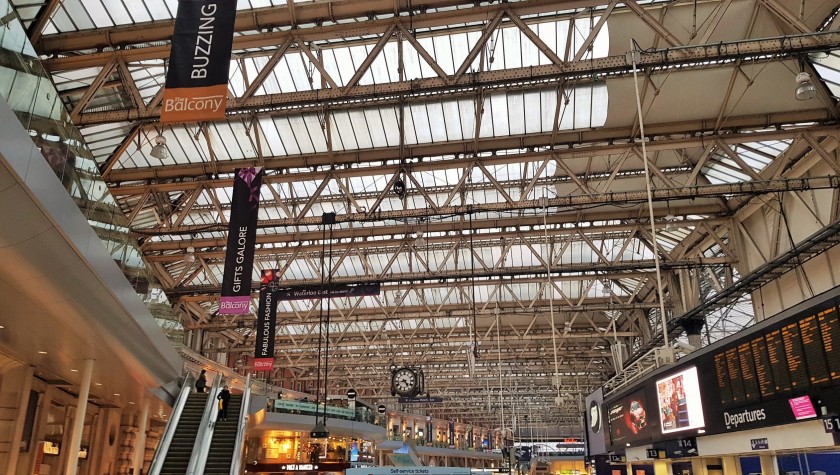
At the other end of the footbridge a lift (elevator) and escalators are available down to the main concourse.
from Liverpool Street
For a Liverpool Street to Waterloo journey the logical option is seemingly making the transfer between the westbound Central line and the Waterloo & City line at Bank station, but the interchange there is comparatively awkward.
So the new, easier option is to take a westbound Elizabeth line train to Tottenham Court Road and then make the transfer there into southbound Northern Line train.
However, if your train heading to Liverpool Street calls at Stratford, a good option is to transfer to the Jubilee line at that station as the Jubilee serves Waterloo.
The Jubilee line trains commence their journeys at Stratford, so if you don't rush to join the next departure, seats and space for luggage will be available.
from Paddington
The Bakerloo line of the Underground provides a direct link from Paddington to Waterloo station, take any southbound train
from St Pancras International
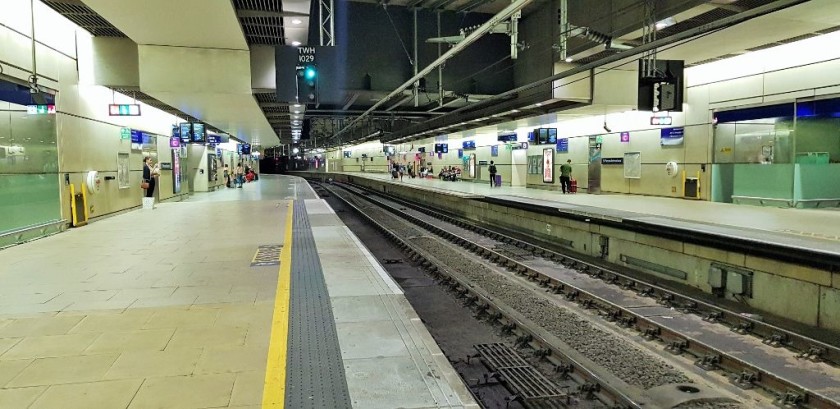
- Take one of the 12 trains an hour from platform A in St Pancras Thameslink station, which will be heading to London Bridge.
- At London Bridge station lifts (elevators) and escalators will enable easy access to platforms 8 and 9, from where all the trains will call at Waterloo (East); trains depart at least every 5 minutes.
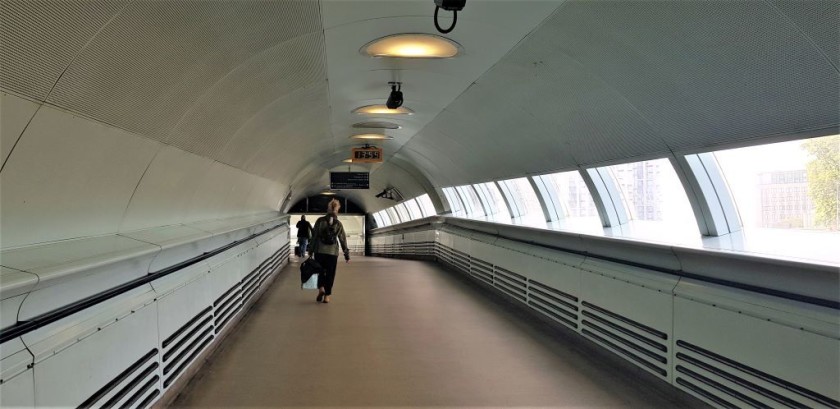
- Waterloo (East) station is adjacent to the main station at Waterloo, to which it has step-free access by a footbridge, though a fairly step slope leads up to it from the trains.
At the other end of the footbridge a lift (elevator) and escalators are available down to the main concourse.
Please support ShowMeTheJourney
This second version of ShowMeTheJourney is exciting and new, so we are genuinely thrilled that you are here and reading this, but we also need your help.
We’re striving not to let anything get in the way of providing the most useful service possible, hence a facility has been set up with DonorBox which can be used to support the running costs and make improvements.
Instead of advertising or paywalls, your financial support will make a positive difference to delivering an enhanced service, as there’s a lot of ideas which we want to make happen.
So if you have found the info provided here to be useful, please go here to say thank you.

Simon Harper
I wanted to share my passion for train travel and explain how anyone can take the fantastic journeys I have taken.

This is one of more than 100 train travel guides available on ShowMeTheJourney, which will make it easier to take the train journeys you want or need to make. As always, all images were captured on trips taken by ShowMeTheJourney.
This second version of ShowMeTheJourney is exciting and new, so we are genuinely thrilled that you are here and reading this, but we also need your help.
We’re striving not to let anything get in the way of providing the most useful service possible, hence a facility has been set up with DonorBox which can be used to support the running costs and make improvements.
Instead of advertising or paywalls, your financial support will make a positive difference to delivering an enhanced service, as there’s a lot of ideas which we want to make happen.
So if you have found the info provided here to be useful, please consider saying thank you.



